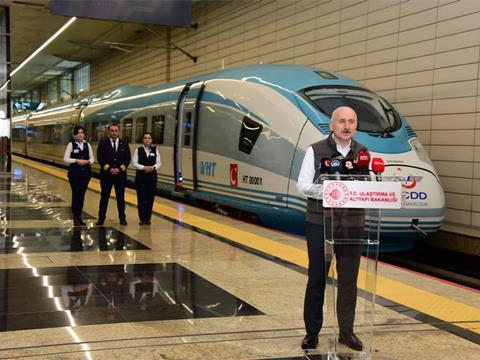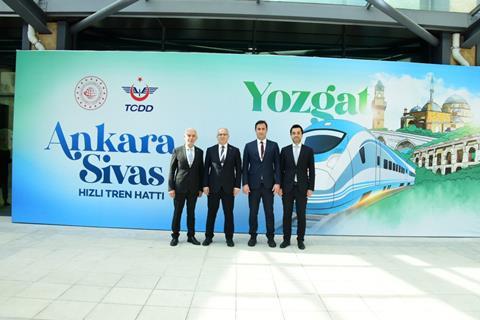
TURKEY: The long-delayed Ankara – Sivas high speed line was formally opened on April 26, when national operator TCDD Taşımacılık ran its first public passenger services over the new route.
The 405 km double-track line heading east from the capital incorporates 112 km of existing alignment as far as Yerköy, but then takes a direct route via Yozgat. This has reduced the distance to Sivas by 198 km compared to the original line through Kayseri, which makes a long diversion to the south.
Speaking ahead of the opening, transport minister Adil Karaismailoğlu said commissioning of the Ankara – Sivas high speed line would increase the country’s high speed network to 2 228 km and the total length of the national rail network to 13 896 km. He added that the new line had been laid with 1 676 km of domestically manufactured rails, the first time these had been used on Turkey’s high speed network.
Services

Trains will be limited to 140 km/h on the 12 km between Ankara and the eastern suburb of Kayaş, but the rest of the line has been built for 250 km/h operation.
This has cut the journey time between Ankara and Sivas from around 10 h 30 min to just 2 h 32 min. The fastest timing from Ankara to the previously unserved town of Yozgat is around 1 h 30 min.
TCDD Taşımacılık is initially operating three high speed services each way per day, departing from both Ankara and Sivas at 08.00, 13.00 and 18.10. Intermediate stops are made at Elmadağ, Kırıkkale, Yerköy, Yozgat, Sorgun, Akdağmadeni and Yıldızeli.
The new line has been built for mixed traffic operation, and is also expected to carry freight trains to and from the eastern border station at Kars. This is a hub for international traffic to and from Central Asia and China.
Construction delays

Work on the Ankara – Sivas line began in February 2009, with opening initially envisaged by 2013. However, the completion date was postponed seven times, following difficulties due to the challenging mountainous terrain and problems with subsidence over one 80 km section.
Construction work involved the boring of 49 tunnels totalling 66 km, of which the longest at Akdağmadeni is 5·1 km. There are 49 viaducts totalling 27·2 km, including a 2·2 km structure between Çerikli and Kırıkkale; the highest at Elmadağ has a height of 89 m.
Multiple contracts were awarded to local and international firms for reconstruction of the existing line and the construction of the new alignment.
Yapi İnşaat was awarded two packages valued at TL586m and TL750m for works on the Kayaş – Elmadağ section, while Söğüt İnşaat was awarded a TL574m contract for the Elmadağ – Kırıkkale section excluding viaducts. Doğuş İnşaat was awarded a TL290m contract for the construction of viaducts between Kayaş and Kırıkkale, while Kolin İnşaat was awarded two packages valued at TL398m and TL248m for work on the Kırıkkale – Yerköy section.
On the new cut-off between Yerköy and Sivas, Özkar Inşaat was awarded a construction contract valued at TL475m, and another for tunnelling worth TL267m. B Ergüner Yol Yapi İnşaat was awarded a TL263m contract for work on section 2 and another of TL76m for the boring of tunnel T341. Generale Costruzioni Ferroviare was awarded a TL277m package for section 3. Özaltin İnşaat was also awarded a TL734m contract for tunnel construction on the Yerköy – Sivas route.

















